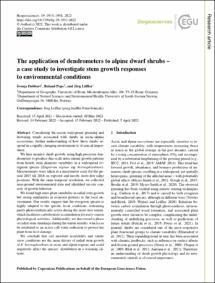Dobbert, Svenja; Pape, Roland; Löffler, Jörg: The application of dendrometers to alpine dwarf shrubs – a case study to investigate stem growth responses to environmental conditions. In: Biogeosciences. 2022, vol. 19, iss. 7, 1933-1958.
Online-Ausgabe in bonndoc: https://hdl.handle.net/20.500.11811/10744
Online-Ausgabe in bonndoc: https://hdl.handle.net/20.500.11811/10744
@article{handle:20.500.11811/10744,
author = {{Svenja Dobbert} and {Roland Pape} and {Jörg Löffler}},
title = {The application of dendrometers to alpine dwarf shrubs – a case study to investigate stem growth responses to environmental conditions},
publisher = {Copernicus},
year = 2022,
month = apr,
journal = {Biogeosciences},
volume = 2022, vol. 19,
number = iss. 7,
pages = 1933--1958,
note = {Considering the recent widespread greening and browning trends associated with shrubs in arctic–alpine ecosystems, further understanding of how these shrubs respond in a rapidly changing environment is of crucial importance. We here monitor shrub growth, using high-precision dendrometers to produce fine-scale intra-annual growth patterns from hourly stem diameter variability in a widespread evergreen species (Empetrum nigrum ssp. hermaphroditum). Measurements were taken at a micrometer scale for the period 2015 till 2018 on exposed and mostly snow-free ridge positions. With the same temporal resolution, we collected near-ground environmental data and identified on-site controls of growth behavior. We found high inter-plant variability in radial stem growth but strong similarities in response patterns to the local environment. Our results suggest that the evergreen species is highly adapted to the specific local conditions, remaining partly photosynthetically active during the snow-free winter, which facilitates carbohydrate accumulation for early-season physiological activities. Additionally, we discovered a phase of radial stem shrinkage during the winter months, which can be attributed to an active cell water reduction to protect the plant from frost damage. We conclude that soil moisture availability and winter snow conditions are the main drivers of radial stem growth of E. hermaphroditum in arctic and alpine regions and could negatively affect the species' distribution in a warming climate.},
url = {https://hdl.handle.net/20.500.11811/10744}
}
author = {{Svenja Dobbert} and {Roland Pape} and {Jörg Löffler}},
title = {The application of dendrometers to alpine dwarf shrubs – a case study to investigate stem growth responses to environmental conditions},
publisher = {Copernicus},
year = 2022,
month = apr,
journal = {Biogeosciences},
volume = 2022, vol. 19,
number = iss. 7,
pages = 1933--1958,
note = {Considering the recent widespread greening and browning trends associated with shrubs in arctic–alpine ecosystems, further understanding of how these shrubs respond in a rapidly changing environment is of crucial importance. We here monitor shrub growth, using high-precision dendrometers to produce fine-scale intra-annual growth patterns from hourly stem diameter variability in a widespread evergreen species (Empetrum nigrum ssp. hermaphroditum). Measurements were taken at a micrometer scale for the period 2015 till 2018 on exposed and mostly snow-free ridge positions. With the same temporal resolution, we collected near-ground environmental data and identified on-site controls of growth behavior. We found high inter-plant variability in radial stem growth but strong similarities in response patterns to the local environment. Our results suggest that the evergreen species is highly adapted to the specific local conditions, remaining partly photosynthetically active during the snow-free winter, which facilitates carbohydrate accumulation for early-season physiological activities. Additionally, we discovered a phase of radial stem shrinkage during the winter months, which can be attributed to an active cell water reduction to protect the plant from frost damage. We conclude that soil moisture availability and winter snow conditions are the main drivers of radial stem growth of E. hermaphroditum in arctic and alpine regions and could negatively affect the species' distribution in a warming climate.},
url = {https://hdl.handle.net/20.500.11811/10744}
}






